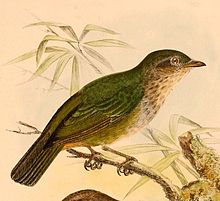Hylocitrea
Appearance
| Hylocitrea[1] | |
|---|---|

| |
| Scientific classification | |
| Kingdom: | |
| Phylum: | |
| Class: | |
| Order: | |
| Family: | see text
|
| Genus: | Hylocitrea Mathews, 1925
|
| Species: | H. bonensis
|
| Binomial name | |
| Hylocitrea bonensis (Meyer & Wiglesworth, 1894)
| |
The hylocitrea (Hylocitrea bonensis), also known as the yellow-flanked whistler or olive-flanked whistler, is a species of bird that is endemic to montane forests on the Indonesian island of Sulawesi.[3] It is monotypic within the genus Hylocitrea, and has traditionally been considered a member of the family Pachycephalidae, but recent genetic evidence suggests it should be placed in a monotypic subfamily of the family Bombycillidae,[4] or even its own family, Hylocitreidae.[1]
References
- ^ a b Gill, F; D Donsker, eds. (2011). "Waxwings to Swallows". IOC World Bird Names (version 2.9). Archived from the original on July 24, 2011. Retrieved 17 August 2011.
{{cite web}}: Unknown parameter|deadurl=ignored (|url-status=suggested) (help) - ^ BirdLife International (2016). "Hylocitrea bonensis". IUCN Red List of Threatened Species. 2016. IUCN: e.T103867190A94017773. doi:10.2305/IUCN.UK.2016-3.RLTS.T103867190A94017773.en. Retrieved 19 February 2017.
- ^ Boles, W. E. (2007). Yellow-flanked Whistler (Hylocitrea bonensis). pp. 411 in: Del Hoyo, J.; Elliot, A., & Christie D. eds. (2007). Handbook of the Birds of the World. Vol. 12. Picathartes to Tits and Chickadees. Lynx Edicions, Barcelona. ISBN 978-84-96553-42-2
- ^ Spellman, G.A.; Cibois, A; Moyle, RG; Winker, K; Keith Barker, F; et al. (2008). "Clarifying the systematics of an enigmatic avian lineage: What is a bombycillid?". Molecular Phylogenetics and Evolution. 49 (3): 691–1044. doi:10.1016/j.ympev.2008.09.006. PMC 2627281. PMID 18824237.

